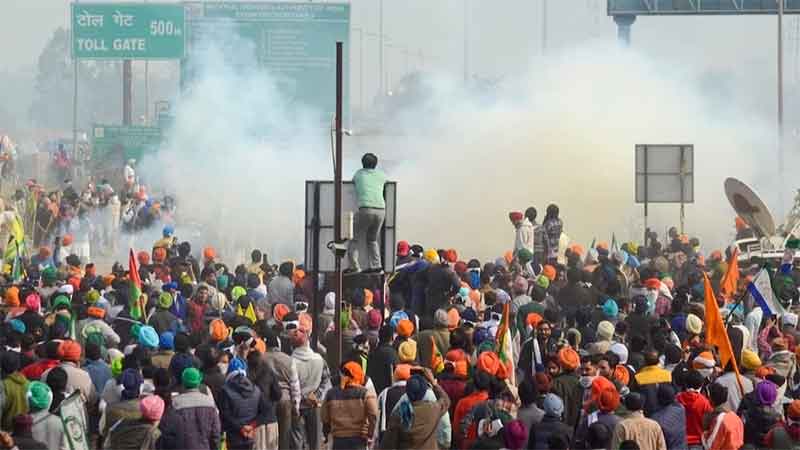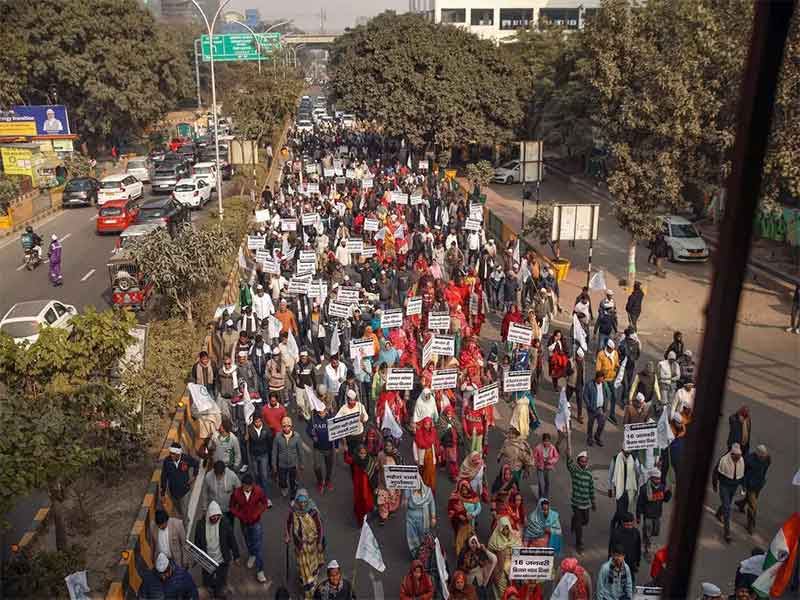
We live in capitalism, its power seems inescapable-but then, so did the divine right of kings. Any human power can be resisted and changed by human beings.
Ursula K. Le Guin
Despite narratives of inferiority imposed by the dominant elites the peasant farmers are creating lasting landscapes of resistance, arising from a new consciousness leading to a re-opening of History. Which forms the basis of all acts of resistance, refusal and self-assertion across India: ‘insurgency’ is the name of that consciousness. Signalling the emergence of a subject – the peasant farmer – shedding their previous obedient subjectivity calling into existence an autonomous collective of people.
This inclusive collective of landed and landless kissans led by a ‘conscious leadership’ is declared an enemy – by the aspiring generalissimo – to be subdued and immobilised. The generalissimo, nurtured, nominated and sustained by the Rashtriya Swayamsevak Sangh in the service of the Indian brahmin-baniya axis tends to treat the revolting peasants as Others to be excluded. Ten rounds of Vigyan Bhavan negotiations were a strategy to weaken the enemy taken out of Tzu’s Art of War: the act of political mediation a mere ruse to weaken the insurgent peasants – the enemy. Played out by the Bharatiya Janatha Party the electoral wing of the RSS, in obeisance to the colonial powers. Since its inception in the 1920s. the RSS never opposed the East India Company nor stood by the Indian freedom movement. And post-Independence further reorienting its policies to align with the economic diktats of the IMF – WB. Bringing into reality the grim contours of a global capitalist project that Marx once described as ‘the entanglement of all peoples in the net of the world market’; fulfilling the upper caste commitment to deliver an exploitable Indian proletariat into the hands of capital. Naturally, the narrative is altered and the ‘ana dada’ becomes an enemy to be encircled, barricaded, attacked and enslaved. Ultimately creating a North Indian enclosure of poverty, and the agricultural land ripe for acquisition by agro-industry monopolies. Achieved through Washington scripted public policy, imperial silence and Farm Laws for the gangsters: to pauperise India by State-sponsored loot of labour, and dispossession of land.
Rooted in the past in1917 at Champaran, Bihar the slogan first raised in colonial India for establishing farmers’ right to control agriculture land, and sale of farm products is now post-independence resonating from the multitude. The autonomous collective unified by a specific demand bridging barriers of culture, class, gender and ideologies – who resisted the British colonial era planters – is now bound together and resisting the right-wing regimes systematic threat of re-colonising India for the brigands. Whose only concern is their current and future profits that would place the Indian billionaires high on the Forbes List? Facilitated policy-wise by the Prime Minister from Gujarat licensing Gujarati billionaires to trample over the lives, and livelihood of millions.
Enabling the upward transfer of wealth by plundering the peasants’ meagre earnings: with policies condoning lower wages, wages theft, unpaid partial employment, and removal of subsidies for the lowest classes. An insurgency against colonial Britain seeded at Champaran under the leadership of Mahatma Gandhi has grown into a ‘gathering with a purpose’ – prelude to a historical Event spreading all over India gathering momentum from 1917 onwards. Cast in hope and defiance the ongoing mobilisation of people display peoples thought coupled with action; the autonomous multitude. Compared with the uprising of 1857 when the Indian sepoys provoked by greased bullets marched to Delhi in rage it was a mobilisation without purpose; the peasants have reached Delhi led by a declared objective ‘Repeal’: multitude ‘gathering with a purpose’. At Delhi, the capital, the locus of the spreading unity is also against global Capital constituted by young and old, men and women, families, increasing in numbers with reluctant police officers, and soldiers contemplating dissent. The growing unity of diverse people will within a short period be referred to as ‘the Indian people’ occupying Delhi.
A single, specific demand that encompasses half a dozen or more reasons justifying uprisings. Thus increasing the possibility of a victory since what is at stake has been engraved in the consciousness of the people. Braving the ravages of weather, the violence of the ‘faceless’ mob and state repression, the autonomous peasant mobilisation is persevering with anticipation of an erasure of the laws. What is unravelled in the constantly growing crowd, is the unfolding of the Event in Delhi; localisation of the site – of an ideological conflict – reconstructed by the unified people: in Trotsky’s words ‘the masses have mounted the stage of history. At this site in Delhi behind concertina wires, iron spikes, and concrete barriers the multitude is reopening History – a simmering pure rebellion without elite political leadership.
The ‘gathering multitude’ itself constitutes the latent subdued and resolute response leading to a ‘present crisis’; a condition that will not return to ‘normal’ (George Mann). Giving rise to a unique popular unity of peasant farmers, and people from non-farming backgrounds. The Farm Laws passed by upper-caste BJP Members of Parliament of which 62% were elected from the Hindi belt has been rejected by the protesting multitude from the same region. A declaration – akin to the voice vote in the Rajya Sabha – rejecting the Farm Laws: a constituting act of the gathering multitude. The living, breathing architecture of the new Parliament of the People – consecrated without Sanskrit chants but slogans -convened along the highways to Delhi is an act retracting their consent to be represented by the majoritarian Members of Parliament. These ‘BJP MP’s from the Hindi belt do not represent us’, elections are a con. A radical re-constitution of peoples Parliament without an electronic voting machine mandate, different from elite politics is a pointer to the emergence of radical alternatives. The new Parliament of the People, the mahapanchayats is the Idea equipped to alter the corrupt, lifeless democracy of India. Is there a new chapter being scripted? In this massively popular event what is distinct is a ‘distancing from state representation’ built on ritual elections. The multitude gathered the insurgents are people who have willfully closed their eyes to the ‘elected majority of representatives’. In Rene Char’s words, ‘if people didn’t sometimes close their eyes tightly, they will end up not seeing what is worth looking at’: aided by willful blindness, a molecular transformation of the insurgent peasant farmers moving into a new consciousness – who dare to shut their eyes to reopen History.
India’s land area of 3.287 million KMs, is one-third of the Peoples Republic of China with a landmass of 9.597 million KMs. Within this land area, Indian peasant farmers produce food and commodities to sustain a population as large as that of China (Kancha Illaiah Shepherd). By cultivating 51% of the Indian landmass the kissan is the defender of the land as opposed to the generalissimo whose abject failure to reclaim Indian territory occupied by the Peoples Liberation Army remains a sore Finger at Ladakh. Yet demeaning the hard work, and labour-power of the peasant farmer in ensuring food security for the nation the generalissimo embarks on an exercise to brand peasant farmers as enemies. The painful reality of this Other-ing strategy to classify and dehumanise is captured in the lines of poet Sachidanand Hiranand Agyeya ‘Jo Pul Banayenge’ about ‘the builders of the setu, the bridge that took Ram and his army across the ocean to Lanka. The setu builders did all the labour but Valmiki wrote them into the story as monkeys’ (quoted in ‘My Son’s Inheritance: A Secret History of Lynching and Blood Justice in India’ by Prof. Aparna Vaidik). Unlike the people who built the bridge and were dehumanised, peasant farmers have scripted their history as people committed to defending territory and food sovereignty. The enemy narrative propagated by the non-food producing upper-caste brahmin dominated media, bureaucracy, and speechwriters are being Rewritten by the peasant farmer. Constituting the multitude, opposing the Farm laws, an opposition that has transformed the many into one; multitude becomes the people.
Who reiterate the role of popular insurgencies as a prelude to emancipation, demonstrating the exercise of state power by the multitude in Delhi, the capital of India. With Gandhi leading the farmers in Champaran the locus has shifted to the capital of the nation and expanded beyond the borders of India. Thus universalizing the power of collective action without authority of the law is the beacon of hope for the people of India and the world – the creative power of mahapanchayats functioning without state intervention arising from the free association of people – ‘the withering away of the state’ (Marx) being scripted in India: embedded in the call to ‘Repeal’ acts of a surrendered Parliament is a dismantling of the Pauranic power hierarchies by the insurgents.
Vinod Kumar Edachery, currently works with a strategic advisory firm in the Middle East. He believes that neoliberalism creates inequality and the transfer of wealth to hegemony. [email protected]
GET COUNTERCURRENTS DAILY NEWSLETTER STRAIGHT TO YOUR INBOX














































